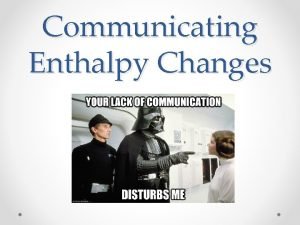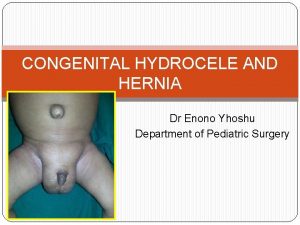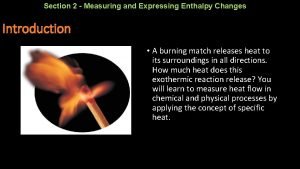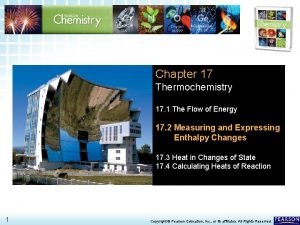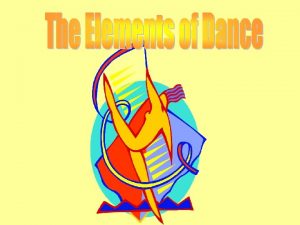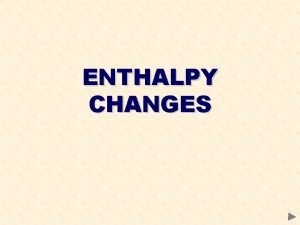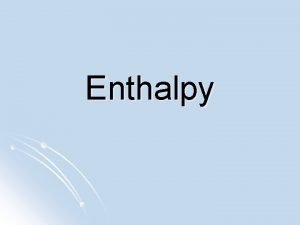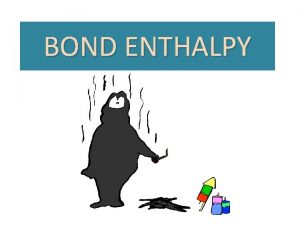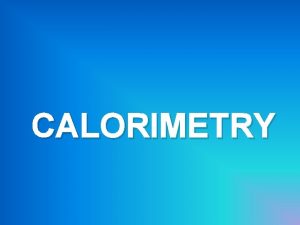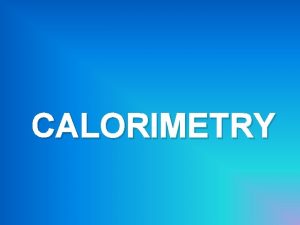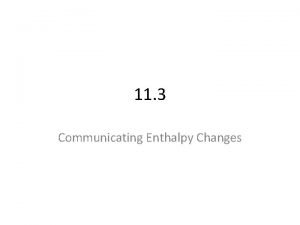Communicating Enthalpy Changes Learning Expectations Communicate and identify










- Slides: 10

Communicating Enthalpy Changes

Learning Expectations Communicate and identify energy changes in chemical reactions using various methods. I’m So excited

Communicating Enthalpy Changes Molar enthalpies can be communicated in 4 ways: 1. Molar enthalpy of a specific reactant 2. Enthalpy change for a balanced reaction equation. 3. Energy value as a term in the reaction equation. 4. Chemical potential energy diagram

Method 1: Molar Enthalpies of Reaction, Δr. Hm Standard molar enthalpy conditions are 100 k. Pa, at an (aq) of 1 mol/L. Liquids and solids must be at 25 ‘C.

Method 2: Enthalpy Change, Δ r. H The Second method is written as an enthalpy change, (Δr. H) beside the chemical equation.

Sulfur dioxide and oxygen react to form sulfur trioxide. The standard molar enthalpy of combustion of sulfur dioxide in this reaction is -98. 9 k. J/mol. What is the enthalpy change for this reaction? The Standard molar enthalpy of combustion of hydrogen sulfide is -518. 0 k. J/mol. Express this value as a standard enthalpy change for the following reaction:

Method 3: Energy Terms in Balanced Equation Method 3 communicates enthalpy change in a chemical reaction by including it as a term in a balanced equation. 2 H 2 O(l) 2 Mg(s) + 2 H 2(g) O 2 + O 2(g) 2 Mg. O ΔH = +571. 6 k. J ΔH = -1203. 2 k. J

Method 4: Chemical Potential Energy Diagrams Show the potential energy of both the reactants and the products of a chemical reaction.

Communicate the energy change of the following reactions using one of the three other methods. 1. C 6 H 12 O 6(s) + 6 O 2(g) 6 CO 2(g) + 6 H 2 O(l) 2. 6 CO 2(g) + 6 H 2 O(l) C 6 H 12 O 6(s) + 6 O 2(g)

Success Criteria I can successfully… ü Communicate energy change using various methods. ü Determine is a reaction is endothermic or exothermic from the energy change in the chemical reaction.
 Communicating enthalpy changes
Communicating enthalpy changes Enthalpy change of solution
Enthalpy change of solution Communicating vs non communicating hydrocele
Communicating vs non communicating hydrocele Measuring and expressing enthalpy changes
Measuring and expressing enthalpy changes Lesson 2: measuring and expressing enthalpy changes
Lesson 2: measuring and expressing enthalpy changes Changes in latitudes, changes in attitudes meaning
Changes in latitudes, changes in attitudes meaning What are chemical changes
What are chemical changes Identify the changes that took place
Identify the changes that took place Cuadro comparativo entre e-learning b-learning y m-learning
Cuadro comparativo entre e-learning b-learning y m-learning Communicating in teams and organizations
Communicating in teams and organizations The area of space occupied by the dancer's body
The area of space occupied by the dancer's body
